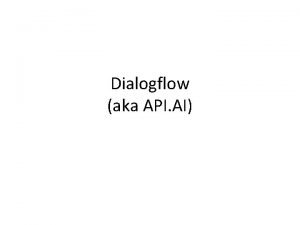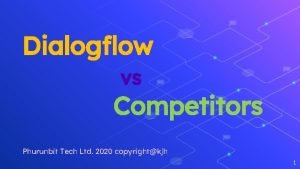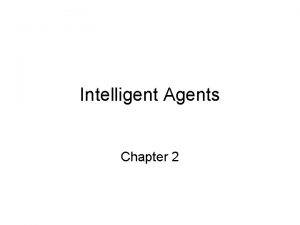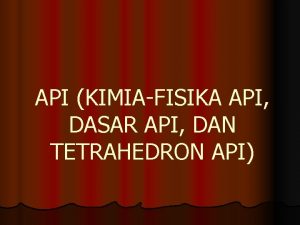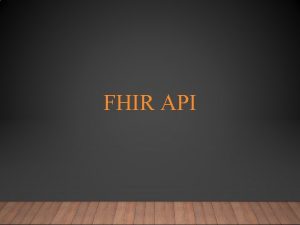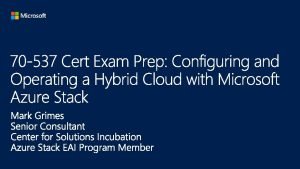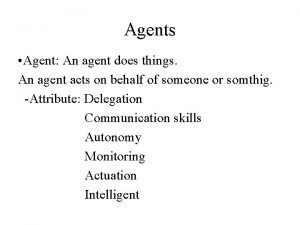Dialogflow aka API AI Agent NLU Natural Language













- Slides: 13

Dialogflow (aka API. AI)

Agent • NLU (Natural Language Understanding) modules • Create new agents • Import predefined agents • Included in your app, product, or service • Contains one or more intents • Designed to manage a conversation flow in a specific way

Prebuilt Agents • Collection of agents developed by the Dialogflow team • Customizable agents that specialize is different areas of knowledge • Examples – Car – Date – Alarm – Weather –…

Intent • Represents a mapping between what a user says and what action should be taken by your software • Intent has the following sections: – User says • Example Mode – Written in natural language and annotated with parameter values – “Weather forecast in Portland tomorrow – Action Parameter values • Steps your application will take when a specific intent has been triggered. – Response • Text, image, card, quick reply, custom payload – Context • Current context of a user's request • Resolves “it” or “them”

Entity • Tool used for extracting parameter values from natural language inputs • Three entity types: – System -- defined by Dialogflow • @sys. date matches common date references such as "January 1, 2015" or "The first of January of 2015" and returns a reference value in ISO-8601 format: 2015 -01 -01 T 12: 00 -03: 00. • @sys. color matches most popular colors and returns the matched color. • @sys. unit-currency matches amounts of money with indication of currency name, e. g. , "50 euros" or "twenty dollars and five cents – Developer --defined by developer • E. g. , @meet, @condiments – User --built for each individual end-user in every request • @playlist • Can be exported and downloaded

Parameters • Parameters are elements generally used to connect words in a user’s response, to entities.

See it in action • https: //www. youtube. com/watch? v=Hqf. N 9 qj Nj 9 A

Actions • step your application will take when a specific intent has been triggered by a user’s input. • Actions can have parameters for extracting information from user requests

Messages • Text • Image • Card – Consist of an image, a card title, a card subtitle, and interactive buttons (for sending user queries or opening links) • Quick reply – Displayed as clickable buttons with pre-defined user responses. • Custom payload

Events • Events is a feature that allows you to invoke intents by an event name instead of a user query

Dialogs • Linear dialogs - the aim of which is to collect the information necessary to complete the required action (e. g. find the best hotel, turn on the right light bulb, or play the desired song) • Non-linear dialogs - which may have several branches, depending on users’ answers

Machine Learning • Machine Learning is the tool that allows your agent to understand a user's interactions as natural language and convert them into structured data • Dialogflow terminology, your agent uses machine learning algorithms to match user requests to specific intents and uses entities to extract relevant data from them.

Training • As you and your users chat with your agent, you can access the conversation logs by clicking Training in the left side menu.
 Dialogflow natural language processing
Dialogflow natural language processing Dialogflow vs lex
Dialogflow vs lex Nlu definition
Nlu definition Nlu
Nlu Natural language processing
Natural language processing Robinhood nlu
Robinhood nlu Reducing agents
Reducing agents Redox potential table
Redox potential table Redox reaction in alkaline medium
Redox reaction in alkaline medium Agent function vs agent program
Agent function vs agent program Agent a chapter 2
Agent a chapter 2 Inorganic emulsifying agents examples
Inorganic emulsifying agents examples Natural hazards vs natural disasters
Natural hazards vs natural disasters Natural capital
Natural capital
